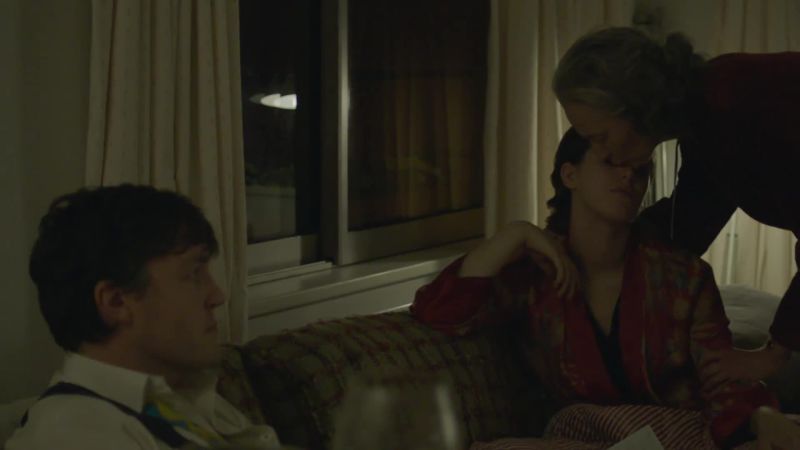
Finding love can be one of the most arduous processes we embark on in our lifetimes. Trying to find the right person with which we click is a trial and error process that unfortunately can have dire consequences if we miss too badly. What makes a person end up partnering with an odious person anyway? What could lead a person to enter a relationship they know is bad for them is something explored in Joanna Hogg’s latest film The Souvenir.
The film follows a young film student named Julie (Honor Swinton Byrne) is embarking on the path toward writing her first creative piece for production. Simultaneously, she begins to date a charming but untrustworthy man named Anthony (Tom Burke). In opposition to her mother Rosalind (Tilda Swinton) and concern from both her friends and his, Julie grows closer to Anthony, accepting all his faults and supporting as best she thinks she can. The toxic relationship threatens to not only destroy Anthony, but the dreams she’s always sought for herself.
In a “life imitating art” twist, as she seeks to write a story of a young boy in love with his mother to the point of obsession, Julie finds herself obsessively in love as well, just not with her mother. The Souvenir documents the development of a toxic relationship in a way that perfectly parallels the way that a person finds themselves in such a predicament in the first place. Julie’s boyfriend Anthony’s behavior subtly hints at his untrustworthiness and deep seated issues, such as the wounds on his arm that he brushes off as an accident and we later learn are where injects heroin. Julie also brushes off the warning signals, taking Anthony’s word or chalking them up as some little thing until the red flags become sirens warning of impending danger that’s now too close to do anything about.
Julie and Anthony’s relationship reminded me of so many I’ve observed and encountered over the course of my life. A person, usually a woman, so foolishly in love, blinded by what could be as an inferior partner, usually a man, drags her down to his level rather than she raising him to hers and she intends and believes is happening. While I’ve never understood the emotional pull involved in ending up in such a relationship, I did find myself relating somewhat to the character of Rosalind. As a third party watching someone you care about be slowly sucked into toxicity, it can be tempting to judge them or yell at them for their illogical decisions that may seem so obviously doomed in your eyes but promising in theirs. But as Rosalind displays in the film, the best way to support a loved one mired in a doomed relationships isn’t to further drive them away through chastisement, but to be there for them when the inevitable results. It’s a tough lesson to learn that you can’t want more for someone than they want for themselves, but learning it is important not only for their well-being and the well-being of the relationship but also for your own mental health. If this sounds similar to waiting for an addict to hit rock bottom so that the path toward wellness can begin, that may not be by accident. Attractions of deprivation, where one person does all of the giving or sacrificing while waiting for reciprocation only to not receive it and invest more time and giving in an attempt to spark said reciprocation, building an emotional sunk cost that is never repaid, often resemble the addictive nature of a drug. Julie’s addiction toward getting it right with Anthony at any cost, despite how futile it often seems, could be seen as a parallel allegory for Anthony’s heroin addiction; the same deadly cycle of chasing a high that can never be caught.
The Souvenir features scenic cinematography, with an emphasis on mirrors; often displaying subjects both directly in front of the camera and through their reflections. Wide angle shots also seem to be a favorite of director Joanna Hogg in the film, often with the subjects diametrically opposed to one another in where they appear. Both the use of reflection and wide shots are artistic but also struck me as storytelling choices with the reflections in the mirror representing the duality created by being a person engaged in a damaging romantic relationship; the choices you make are almost as if you’re operating outside of yourself, against your better judgement that you would normally display, with your wiser self left standing by the wayside helplessly watching you destroy your inner peace and tranquility. That Julie and Anthony are always staged in a manner with them standing opposite each other in sort of a standoff an obvious representation of how bad their union is and what opposites they are, or when Julie and her mother are staged in a similar manner, depicting how Rosalind wants more for her child than she is currently accepting.
The Souvenir is an extremely slow burn of a film, taking the entire first half of its two hour run time to get going and begin to develop an engrossing story. Once we arrive to the point of the film and figure out what director Joanna Hogg is trying to tell us, many viewers will find the story (unfortunately) relatable and something that speaks to them. While I found the slow development of the film to be a great metaphor for the type of relationship that it depicts, it was tough sledding getting there and many people won’t find the journey to be worth the payoff. The film is interesting visually with the camera work, angling, and production design, providing an artsy flair that makes it at least good to look at whenever the story lags. While The Souvenir is tough sledding at first, its relatable storyline makes for a somewhat interesting watch for those who don’t see themselves in the metaphorical reflections mirrored by its plot.
Image: A24

